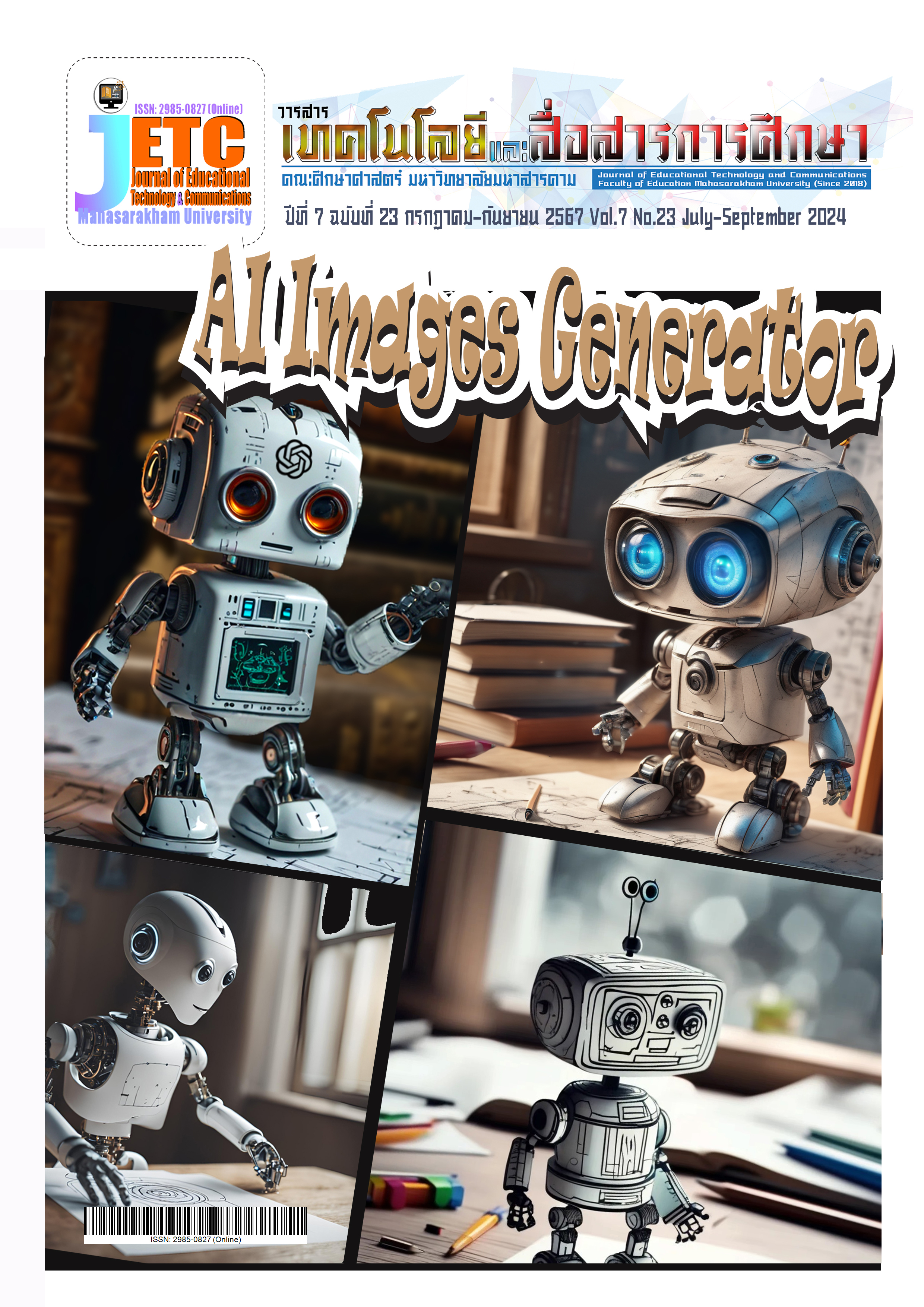Development Skills in Using the Program Microsoft Word through a Peer-Assisted Learning Management Approach Combined with Computer-Assisted Instruction for Grade 6th Students
Main Article Content
Abstract
The purpose of this study was to (1) develop the efficiency of learning management based on computer-assisted instruction for Microsoft Word Program blended with the Peer-Assisted learning management with the related efficiency criterion of 80/80 (2) to compare the Microsoft Word skills of the students between before and after learning based on computer-assisted instruction blended with the Peer-Assisted learning management, and (3) to study the students’ satisfaction towards learning based on computer-assisted instruction blended with Peer-Assisted learning management.The research sample was composed of 10 students in grade six class that assigned by cluster random sampling method. The research instruments were comprised of 1) the learning management plans, 2) the test of the Microsoft Word program, and 3) a questionnaire to assess the students’ satisfaction towards learning based on computer-assisted instruction blended with Peer-Assisted learning management. The data obtained were analyzed using distribution, percentage, mean, standard deviation, and test for research hypothesis with t-test for dependent-samples.
The result showed that
1. the efficiency of Peer-Assisted learning management blended with Computer-Assisted Instruction was found at 78.40/80.60
2. the student’s skills in using the Microsoft Word program after learning based on Peer- Assisted learning management blended with Computer-Assisted Instruction was higher than before learning at the significant level of .01 whereas revealed the t-test value of 16.661
3. the overall students’ satisfaction towards the Peer-Assisted learning management blended with Computer-Assisted Instruction was found in overall average at a high level (=4.25, S.D.=0.74). Considering in each component, it was found in average descending order of students’ satisfaction towards teacher behaviors (
=4.57, S.D.=0.58), the knowledge contents (
=4.32, S.D.=0.73), the learning management activities (
= 4.27,S.D. = 0.72), the media and learning materials (
=4.18, S.D.=0.87), and the evaluation for learning (
=3.93, S.D.=0.75) respectively.
Downloads
Article Details
References
กระทรวงศึกษาธิการ. (2561). ตัวชี้วัดและสาระการเรียนรู้แกนกลางกลุ่มสาระการเรียนรู้การงานอาชีพและเทคโนโลยี (ฉบับปรับปรุง พ.ศ. 2560) ตามหลักสูตรแกนกลางการศึกษาขั้นพื้นฐานพุทธศักราช 2551. โรงพิมพ์ชุมนุมสหกรณ์การเกษตรแห่งประเทศไทย.
กระทรวงศึกษาธิการ. (2560). การศึกษาไทย 4.0. โรงพิมพ์ชุมนุมสหกรณ์การเกษตรแห่งประเทศไทย.
กระทรวงศึกษาธิการ. (2551). ตัวชี้วัดและสาระการเรียนรู้แกนกลางกลุ่มสาระการเรียนรู้การงานอาชีพและเทคโนโลยีตามหลักสูตรแกนกลางการศึกษาขั้นพื้นฐานพุทธศักราช 2551. โรงพิมพ์ชุมนุมสหกรณ์การเกษตรแห่งประเทศไทย.
โกเมศ แดงทองดี. (2561). การศึกษาในยุค Thailand 4.0. วารสารการอาชีวศึกษาภาคกลาง, (1), 1-6.https://so01.tci-thaijo.org/index.php/NBU/article/view/251680
เชน ชวนชม. (2561). การพัฒนาบทเรียนออนไลน์ วิชาเทคโนโลยีสารสนเทศในชีวิตประจำวัน เรื่อง การใช้งานโปรแกรม Microsoft office สำหรับนิสิตระดับปริญญาตรี ชั้นปีที่ 1 มหาวิทยาลัยบูรพา. วารสารวิชาการ สถาบันการพลศึกษา, 10(3), 3-5.
ณัฐริน เจริญเกียรติบวร และมัทนา วังถนอมศักดิ์. (2560). คอมพิวเตอร์ช่วยสอนเรื่องการทำงานของคอมพิวเตอร์ สำหรับนักเรียนชั้นมัธยมศึกษาปีที่ 1 กลุ่มสาระการเรียนรู้การงานอาชีพและเทคโนโลยี โรงเรียนทีปังกรวิทยาพัฒน์ ทวีวัฒนา) ในพระราชูปถัมภ์ ฯ, Veridian E-Journal, SilpakornUniversity: ฉบับภาษาไทย มนุษยศาสตร์ สังคมศาสตร์ และศิลปะ. 10(2), 2088-2101. https://he02.tci-thaijo.org/index.php/Veridian-E-Journal/article/view/103438
พาสนา จุลรัตน์. (2561). การจัดการเรียนรู้สำหรับผู้เรียนในยุค Thailand 4.0. Veridian E-Jurnal Silpakorn University : ฉบับภาษาไทย สาขามนุษยศาสตร์ สังคมศาสตร์ และศิลปะ, 11(2), 2363-2380. https://he02.tci-thaijo.org/index.php/Veridian-E-Journal/article/view/144570
สุนันท์ สีพาย. (2562). บทบาทของครูไทยในการศึกษา 4.0. วารสารการวัดผลการศึกษา มหาวิทยาลัยมหาสารคาม,25(2), 3-14. https://so02.tci-thaijo.org/index.php/jemmsu/article/view/231917
อาภรณ์ศิริ พลรักษา. (2561). การพัฒนาความสามารถในการเรียนรู้คำศัพท์ภาษาอังกฤษโดยใช้เกมสำหรับนักเรียนชั้นประถมศึกษาปีที่ 4. [วิทยานิพนธ์ปริญญามหาบัณฑิต, มหาวิทยาลัยราชภัฏมหาสารคาม]. https://fulltext.rmu.ac.th/fulltext/2561/M126619/Phonraksa%20Apornsiri.pdf
Vestberg, H. (Sep 21, 2018). Why we need both science and humanities for a Fourth Industrial Revolution education. https://www.weforum.org/agenda/2018/09/why-we-need-both-science-and-humanities-for-a-fourth-industrial-revolution-education/

